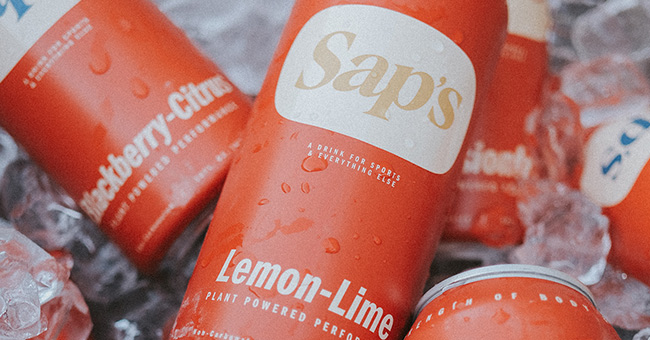For years, average people have been consuming the same sports drinks that they watch marketed on TV by elite-caliber athletes, which are backed by investments in scientific research and fine-tuned product development (or so we’re meant to believe).
Now first-time beverage entrepreneur Jordan Wilson believes it’s time for the normals to have their say in the category with Sap’s, which bills itself as “a drink for sports & everything else.”
As an entrepreneur, beverages weren’t always on Wilson’s radar; his first passion was clothing. After launching his own apparel startup as a college student, the Midland, Texas-native later joined a menswear startup as a product developer, but quickly found himself running both retail and online operations six months later. He would eventually leave after three years and parlay that experience into creating his own operations consultancy, which brought him in touch with fast-growing hydration brand BIOLYTE in 2019. At the time, BIOLYTE “was two employees, and they had just done probably about $800,000 in sales,” Wilson said.
“I understood what it would take to help scale a business, but I didn’t know CPG. But really just jumping in and being almost at a full-time capacity over the course of that year I started learning a ton about, this is how you work with distributors, this is how you get new business, this is how chains think about bringing in new products, and really just kind of fell in love with the industry.”
After three years working with BIOLYTE, Wilson reconnected with a college friend Trey Marler, president of Craft Health in Austin, who offered him the opportunity to steer a new drink venture, Sap’s, that would see him playing in a similar rapid-hydration space as BIOLYTE. Both are seeking to shake up the sports drink-slash
-hydration category, which Wilson claims is rife with products that “don’t really work that well” or that “taste terrible.”
In creating the brand’s retro aesthetic and inclusive attitude, Wilson referenced the rise of Liquid Death, and while Sap’s branding features considerably less blood and gore, the idea of authenticity and engagement is the same. The tallboy can format ticks many of the same sustainability and convenience boxes as the water brand, and similarly works better in non-traditional settings for sports drinks, like concert venues and breweries, Wilson noted.
In Sap’s case, the target for disruption is a category that has leaned into high-performance athletes at the expense, Wilson argues, of the common man.
“I’m not saying that we’re like Liquid Death, but it’s this same kind of this mindset of let’s make something that’s this really cool and retro and a lot edgier than current sports drink hydration brands, and that is going after your average person that could be running a marathon this past weekend or loves to skateboard or loves to go on hiking trips or hunting or fishing.”
But on the shelf, Sap’s is taking on the likes of Gatorade, BodyArmor and, in particular, Electrolit, which “kind of dominates” the Texas market, according to Wilson. In building its name, the brand has focused on forging alliances with alcohol distributors in the region, like Ben E. Keith Co. and Golden Eagle. Wilson is targeting an eventual 80/20 split between retail (mainly grocery and convenience) and online sales, but for the moment, Sap’s is focused on just building its name. That work falls mainly on Sean Curran, a former marketing VP at Ranch Rider Spirits and Sap’s current head of brand, while Michael Cevasco (Lone River Brewing) works as VP of sales.
Sap’s isn’t alone in targeting that space. Los Angeles-based startup Courtside has forged a similar path in developing a coconut water-based hydration play aimed at “leisure sports” and active lifestyles, while Leisure Project has similarly created a canned hydration drink intended for the everyday consumer. The grassroots rise of sports like pickleball has also offered nascent beverage brands — including Sap’s, which sponsored a local professional event in Austin — a way to sidestep their deep-pocketed rivals and access new marketing opportunities. Some brand building work has been as simple as handing out cans to concertgoers leaving the annual Austin City Limits music festival.
“It’s really been all about finding those kinds of niche activity-based things and having fun with it,” Wilson said. “Because I don’t see somebody like Electrolit — they’re not going to sponsor a pickleball tournament or something along those lines.”

